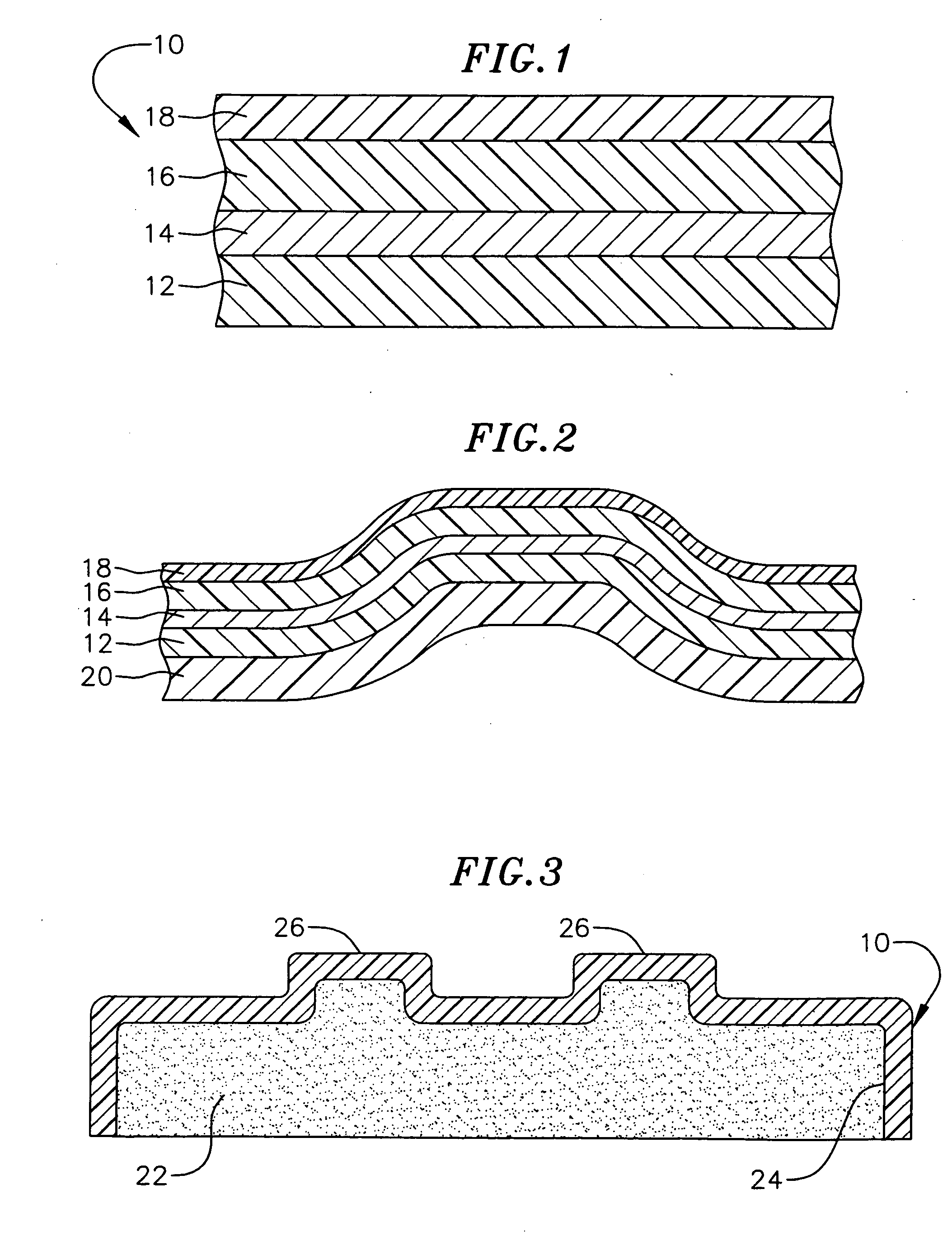Bright formable metalized film laminate
- Summary
- Abstract
- Description
- Claims
- Application Information
AI Technical Summary
Benefits of technology
Problems solved by technology
Method used
Image
Examples
example 1
[0042] An 8 mil urethane sheet supported on one side by a polyester carrier was placed in a bell jar vacuum metalization apparatus. A 0.06 gram piece of indium was then placed in an evaporation boat. A vacuum was drawn and an electric current was applied to the evaporation boat. The indium piece melted by vaporization and was deposited on the urethane sheet. The vacuum chamber was vented and the sample removed. Urethane sheets of 2, 3 and 6 mil thickness were also used successfully in this process.
[0043] Clear sheets of thermoplastic material such as polycarbonate and acrylic resin were cut to the same size as the 8 mil urethane sheet. A thickness range of the clear sheet was between 10-20 mils although the acrylic as thin as 2.5 mils was used successfully. For the polycarbonate sheet a PVDF / acrylic over-laminate was laminated to the outer surface. The overlaminate comprised Kynar 500 Plus PVDF and Elvacite 2042 from Ineos. The metalized side of the urethane sheet was placed on the...
example 2
[0046] A 2 mil urethane baseweb was metalized in line. A roll of 2 mil urethane film supported by a polyester carrier was placed in a vacuum metallization apparatus. The urethane roll was 19 inches wide. Four rolls of indium wire were also placed in the apparatus. The wire was unwound and fed into four evaporation boats. A vacuum was drawn in the apparatus, and an electric current was applied to the boats. The indium wire melted and was vaporized under the vacuum. The wire was fed continuously into the boats, and the vaporized indium was deposited on the urethane as it was unrolled. After the entire roll was coated, the vacuum chamber was vented and the roll removed.
[0047] A clear roll of thermoplastic polycarbonate was slit to the same width as the roll of metalized 2 mil urethane. The polycarbonate thickness was 7 mils. The metalized side of the 2 mil urethane film was heat and pressure laminated to the polycarbonate sheet. This resulted in a permanent bond between the metalized ...
example 3
[0049] Samples of the construction described in Example 2 were placed in accelerated weathering apparatuses, including Xenon Weatherometer and QUV. After approx. 500 hours exposure, a haze developed on the surface of the samples. The haze grew progressively worse with time. It was believed that the haze might be UV absorber migrating to the surface of the PVDF / acrylic overlaminate film. This haze also occurred in outdoor Florida exposure after 6 months.
[0050] To solve this problem, an L9 design of experiments (DOE) was conducted to evaluate different UV absorbers in the PVDF / acrylic coating. Tinuvin 400, Tinuvin 928, and Tinuvin 900 (control) were evaluated. The same PVDF / acrylic resins as Examples 1 and 2, at the same ratio, were used. PVDF / acrylic topcoat thicknesses of 0.5, 1.0, and 2.0 mils were evaluated.
[0051] After 500 hours exposure, the L9 samples were compared. Samples with the Tinuvin 400 and 928 showed superior results to the Tinuvin 900 samples, with respect to preven...
PUM
| Property | Measurement | Unit |
|---|---|---|
| Temperature | aaaaa | aaaaa |
| Temperature | aaaaa | aaaaa |
| Temperature | aaaaa | aaaaa |
Abstract
Description
Claims
Application Information
 Login to View More
Login to View More - R&D
- Intellectual Property
- Life Sciences
- Materials
- Tech Scout
- Unparalleled Data Quality
- Higher Quality Content
- 60% Fewer Hallucinations
Browse by: Latest US Patents, China's latest patents, Technical Efficacy Thesaurus, Application Domain, Technology Topic, Popular Technical Reports.
© 2025 PatSnap. All rights reserved.Legal|Privacy policy|Modern Slavery Act Transparency Statement|Sitemap|About US| Contact US: help@patsnap.com

